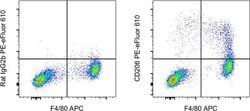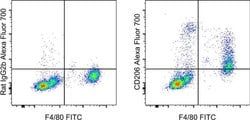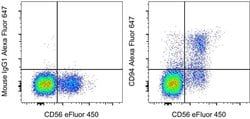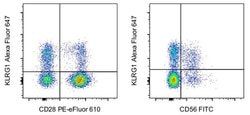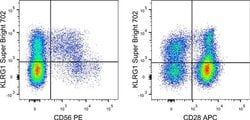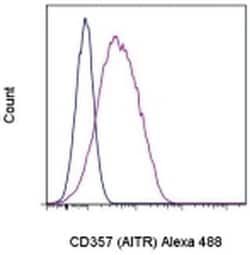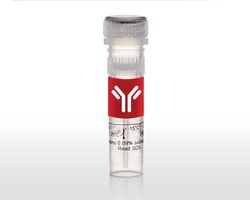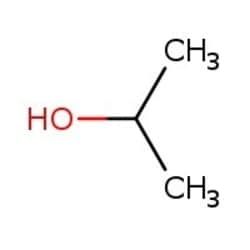CD206 (MMR) Monoclonal Antibody (19.2), Alexa Fluor™ 700, eBioscience™, Invitrogen™
Manufacturer: Invitrogen
Select a Size
| Pack Size | SKU | Availability | Price |
|---|---|---|---|
| Each of 1 | 56-206-942-Each-of-1 | In Stock | ₹ 25,988.00 |
56-206-942 - Each of 1
In Stock
Quantity
1
Base Price: ₹ 25,988.00
GST (18%): ₹ 4,677.84
Total Price: ₹ 30,665.84
Antigen
CD206 (MMR)
Classification
Monoclonal
Concentration
5 μL/Test
Formulation
PBS with 0.2% BSA and 0.09% sodium azide, pH 7.2
Gene Accession No.
P22897
Gene Symbols
Mrc1
Purification Method
Affinity chromatography
Regulatory Status
RUO
Gene ID (Entrez)
4360
Content And Storage
4° C, store in dark, DO NOT FREEZE!
Form
Liquid
Applications
Flow Cytometry
Clone
19.2
Conjugate
Alexa Fluor 700
Gene
Mrc1
Gene Alias
AW259686, bA541I19.1, CD206, CELE_Y39A3CR.4, CLEC13D, CLEC13DL, C-type lectin domain family 13 member D, C-type lectin domain family 13 member D-like, ddp-1, hMR, Human mannose receptor, macrophage mannose receptor 1, Macrophage mannose receptor 1-like protein 1, mannose receptor, C type 1, mannose receptor, C type 1-like 1, Mitochondrial import inner membrane translocase subunit Tim8, MMR, MR, MRC1, MRC1L1, tim-8, Y39A3CR.4
Host Species
Mouse
Quantity
100 Tests
Primary or Secondary
Primary
Target Species
Human
Product Type
Antibody
Isotype
IgG1 κ
Description
- Description: This 19.2 monoclonal antibody reacts with human CD206, which is also known as the macrophage mannose receptor (MMR)
- CD206 is expressed on macrophages and dendritic cells
- This type I transmembrane protein can also be detected on non-immune cells, including hepatic and lymphathic epithelia and kidney mesengial cells
- CD206 binds to glycoproteins that terminate in D-mannose, L-fucose, or N-acetylglucosamine, as well as a variety of hormones
- This receptor undergoes constitutive internalization and recycling between the plasma membrane and the endosomal compartment
- CD206 is involved in antigen processing and presentation, cell migration, and intracellular signaling
- Moreover, CD206 plays a key role in phagocytosis pathogens such as Candida albicans, Leishmania, and Mycobacterium tuberculosis
- Applications Reported: This 19.2 antibody has been reported for use in flow cytometric analysis
- Applications Tested: This 19.2 antibody has been pre-diluted and tested by flow cytometric analysis of stimulated normal human peripheral blood cells
- This may be used at 5 μL (0.06 μg) per test
- A test is defined as the amount (μg) of antibody that will stain a cell sample in a final volume of 100 μL
- Cell number should be determined empirically but can range from 10^5 to 10^8 cells/test
- Alexa Fluor 700 emits at 723 nm and can be excited with the red laser (633-647 nm)
- Most instruments will require a 685 LP mirror and 710/20 band pass filter
- CD206 (MSR, Mannose receptor, MRC1) is a 175 kDa transmembrane protein belonging to the group of pattern recognition receptors
- CD206 is predominantly expressed in tissue macrophages, dendritic cells, a subpopulation of endothelial cells and sperm cells
- CD206 is thought to play a role in the innate and adaptive immune response
- CD206 is also expressed on microglia and mato cells of the brain but not astrocytes or neurons
- CD206 also mediate the recognition and uptake of a variety of macromolecules, including modified lipoproteins, advanced glycation end (AGEs) products and amyloid b-protein (Abeta)
- While the normal role of CD206 is associated with cell adhesion and host defense mechanisms, it also has been implicated in the development of atherosclerosis and Amyloid beta deposition in Alzheimer's disease (AD)
- CD206’s gene encodes the class A macrophage scavenger receptors, which include three different types (1, 2, 3) generated by alternative splicing
- The isoforms type 1 and type 2 are functional receptors and are able to mediate the endocytosis of modified low density lipoproteins (LDLs)
- The isoform type 3 does not internalize modified LDL (acetyl-LDL) despite having the domain shown to mediate this function in the types 1 and 2 isoforms
- CD206 has an altered intracellular processing and is trapped within the endoplasmic reticulum, making it unable to perform endocytosis
- The isoform type 3 can inhibit the function of isoforms type 1 and type 2 when co-expressed, indicating a dominant negative effect and suggesting a mechanism for regulation of scavenger receptor activity in macrophages
- Other diseases associated with CD206 dysfunction include leprosy and Gaucher’s Disease.
